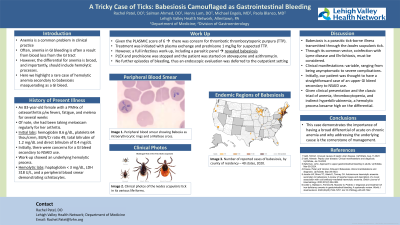Sunday Poster Session
Category: GI Bleeding
P0766 - A Tricky Case of Ticks: Babesiosis Camouflaged as Gastrointestinal Bleeding
Sunday, October 27, 2024
3:30 PM - 7:00 PM ET
Location: Exhibit Hall E

Has Audio
.jpg)
Rachel Patel, DO
Lehigh Valley Health Network
Coopersburg, PA
Presenting Author(s)
Rachel Patel, DO1, Salman Ahmed, DO2, Henry Lam, DO2, Michael Engels, MD3, Paola Blanco, MD3
1Lehigh Valley Health Network, Coopersburg, PA; 2Lehigh Valley Health Network, Allentown, PA; 3Eastern Pennsylvania Gastrointestinal and Liver Specialists, Allentown, PA
Introduction: Anemia is a common problem in clinical practice. Often, this is a result of blood loss from the gastrointestinal tract. Its prevalence among patients with GI bleeding has been estimated to be 61%. However, the differential for anemia is broad, and importantly, should include hemolytic processes. Here, we highlight a rare case of hemolytic anemia secondary to babesiosis masquerading as a GI bleed.
Case Description/Methods: An 83-year-old female with a past medical history of osteoarthritis presented with fevers, fatigue, and melena ongoing for several weeks. Over the past few days, she started experiencing slurred speech and altered mentation. Of note, she had been taking meloxicam regularly for her arthritis. Labs on arrival were significant for anemia, hemoglobin 8.6 g/dL, thrombocytopenia, platelets 64 thou/cmm, elevated BUN/Cr ratio 49, and mild hyperbilirubinemia with tbili of 1.2 mg/dL and dbili of 0.4 mg/dL. Initially, there were concerns for a GI bleed secondary to NSAID use. However, upon further investigation, there were concerns for an underlying hemolytic process driving her overall clinical picture. Her hemolytic labs showed low haptoglobin < 3 mg/dL, elevated LDH 318 U/L, and a peripheral blood smear demonstrating schistocytes. The patient was empirically started on plasma exchange and prednisone 1 mg/kg for possible TTP given an elevated PLASMIC score of 6. However, a full infectious workup, including a parasitic panel, ultimately revealed babesiosis. She was then started on atovaquone and azithromycin. Endoscopic workup was deferred to the outpatient setting given she had no further episodes of bleeding once platelets recovered upon adequate treatment.
Discussion: Babesiosis is a parasitic tick-borne illness transmitted through the Ixodes scapularis tick. Given its common vector, coinfection with other tick-borne pathogens, including Lyme disease and Ehrlichiosis must be considered. Clinical manifestations of babesiosis are variable, ranging from being asymptomatic to severe complications. Initially, our patient was thought to have a straightforward case of an upper GI bleed secondary to NSAID use. However, accounting for her overall clinical presentation and the classic triad of anemia, thrombocytopenia, and indirect hyperbilirubinemia, a hemolytic process became high on the differential. This case demonstrates the importance of having a broad differential to acute on chronic anemia and why addressing the underlying cause is the cornerstone of management.
Disclosures:
Rachel Patel, DO1, Salman Ahmed, DO2, Henry Lam, DO2, Michael Engels, MD3, Paola Blanco, MD3. P0766 - A Tricky Case of Ticks: Babesiosis Camouflaged as Gastrointestinal Bleeding, ACG 2024 Annual Scientific Meeting Abstracts. Philadelphia, PA: American College of Gastroenterology.
1Lehigh Valley Health Network, Coopersburg, PA; 2Lehigh Valley Health Network, Allentown, PA; 3Eastern Pennsylvania Gastrointestinal and Liver Specialists, Allentown, PA
Introduction: Anemia is a common problem in clinical practice. Often, this is a result of blood loss from the gastrointestinal tract. Its prevalence among patients with GI bleeding has been estimated to be 61%. However, the differential for anemia is broad, and importantly, should include hemolytic processes. Here, we highlight a rare case of hemolytic anemia secondary to babesiosis masquerading as a GI bleed.
Case Description/Methods: An 83-year-old female with a past medical history of osteoarthritis presented with fevers, fatigue, and melena ongoing for several weeks. Over the past few days, she started experiencing slurred speech and altered mentation. Of note, she had been taking meloxicam regularly for her arthritis. Labs on arrival were significant for anemia, hemoglobin 8.6 g/dL, thrombocytopenia, platelets 64 thou/cmm, elevated BUN/Cr ratio 49, and mild hyperbilirubinemia with tbili of 1.2 mg/dL and dbili of 0.4 mg/dL. Initially, there were concerns for a GI bleed secondary to NSAID use. However, upon further investigation, there were concerns for an underlying hemolytic process driving her overall clinical picture. Her hemolytic labs showed low haptoglobin < 3 mg/dL, elevated LDH 318 U/L, and a peripheral blood smear demonstrating schistocytes. The patient was empirically started on plasma exchange and prednisone 1 mg/kg for possible TTP given an elevated PLASMIC score of 6. However, a full infectious workup, including a parasitic panel, ultimately revealed babesiosis. She was then started on atovaquone and azithromycin. Endoscopic workup was deferred to the outpatient setting given she had no further episodes of bleeding once platelets recovered upon adequate treatment.
Discussion: Babesiosis is a parasitic tick-borne illness transmitted through the Ixodes scapularis tick. Given its common vector, coinfection with other tick-borne pathogens, including Lyme disease and Ehrlichiosis must be considered. Clinical manifestations of babesiosis are variable, ranging from being asymptomatic to severe complications. Initially, our patient was thought to have a straightforward case of an upper GI bleed secondary to NSAID use. However, accounting for her overall clinical presentation and the classic triad of anemia, thrombocytopenia, and indirect hyperbilirubinemia, a hemolytic process became high on the differential. This case demonstrates the importance of having a broad differential to acute on chronic anemia and why addressing the underlying cause is the cornerstone of management.
Disclosures:
Rachel Patel indicated no relevant financial relationships.
Salman Ahmed indicated no relevant financial relationships.
Henry Lam indicated no relevant financial relationships.
Michael Engels indicated no relevant financial relationships.
Paola Blanco indicated no relevant financial relationships.
Rachel Patel, DO1, Salman Ahmed, DO2, Henry Lam, DO2, Michael Engels, MD3, Paola Blanco, MD3. P0766 - A Tricky Case of Ticks: Babesiosis Camouflaged as Gastrointestinal Bleeding, ACG 2024 Annual Scientific Meeting Abstracts. Philadelphia, PA: American College of Gastroenterology.

